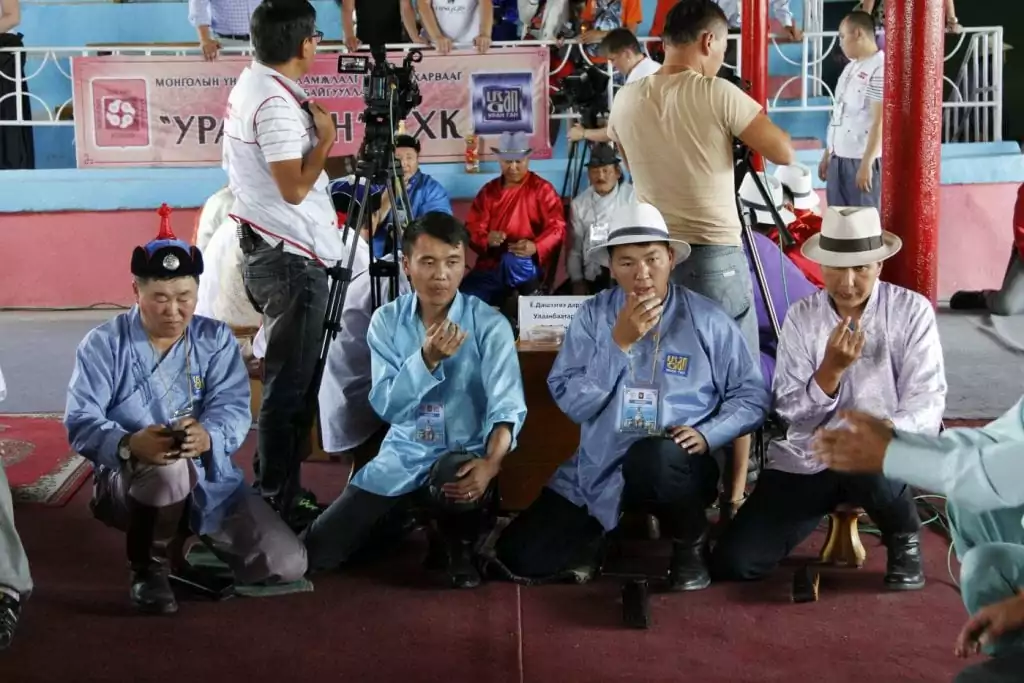Shagai (Anklebone) games are an important part of Mongolian traditional games. There are myriad kinds of anklebone games which attract both children and adults. Researchers identified 80 variations of Mongolian ankle bone games, such as “Catch Ankle Bones”, “Flick Anklebones”, “Horse Race”, “Wrestling”, “Set Four Difficult”, “Calculation”, “Guessing”, “Comply Four Colours”, “Construct A Star”, “Cat Taking”, “Vow”, “Nine Wisdoms”, “Birth of Camel” and “Multicoloured Turtle”. After finishing everyday duties and during the occasions that happen once a year, such as carding a goat, shearing of sheep, and felt making during which they gather all relatives and neighbors, Mongolians play games like “Throw White Wood”, “Multicoloured Turtle”, and “Catch Ankle Bones”. Children mainly play flicking shagai and running horse race. Anklebone(shagai) games are important merrymakers, and at the same time, they help to develop intelligence, increase creative thinking and exercise hand, finger movements, challenge eyesight and concentration as well as foster collective identity.
The Catching Of Anklebones(Shagai)
Depending upon the number of shagai, the number of players can be established. The players place a rug or quilted felt rug and scatter ankle bones over the rug and sit around the rug. The senior or honorary person starts playing. The players’ play ankle bones alternate according to clockwise. There is a piece of mail imitating the armor of ancient warriors. This piece is called the “arrow” or piece of mail. The player tosses up the piece of mail toward the air. Before the fall of a piece of mail, the player collects anklebones(shagai) as much as possible and clenches them in the palm and receives the tossed piece of mail at its palm without letting the piece of mail fall on the ground. Each player passes its turn to the next player if touches other scattered anklebones(shagai), except its clenched anklebones(shagai), anklebones slip out of the player’s hand or the player does not receive the tossed piece of mail on its palm. If the player does not make a mistake, the player can continue to play. In such a way the player continues and collects all the scattered anklebones from the rug, after which the playing is over. Players can play again with the stock gathered from the ankle-bones from each player. The player, who has no ankle-bones, must leave the play. The player, who collects all the ankle-bones, can be the winner. The last player can start the second round. There are several strict rules of a game. When the player seizes those anklebones, fifteen or twenty ankle-bones may remain. In that case, there is an attempt to attack them. This is called “attack” or dairakh. When they attack ankle-bones, they need to seize all of them. If they take all of the ankle-bones, it is called “taken a package” or “bagts avakh”. If there are ankle bones under ten, the player needs to take them without letting to fall single ankle-bone. It is called “tail” or “süül” when a player succeeds in taking all the ankle-bones, but one ankle-bone slips out of the hand. If the player thinks that he/she is unable to take all of the anklebones, he/she can take only one ankle-bone and passes his/her turn to play. It is called “cracking” or “tsömökh”. If there are four pieces of ankle-bones, the player may pick each without remnant. It is called “picking” or “tovshij avakh”.

Anklebone Flicking
Any number of people can be involved in the anklebone flicking game. Anklebones are spread out on a rug and the players hit the same positioned ankle bones by flicking and pick them by his/her choice. The four sides of anklebone are called the sheep, goat, horse, and camel. They have to be flicked by same figures like a horse by horse, sheep by sheep etc. After hitting the anklebones, the player picks up one of them. The choice depends on which one can be useful for the next shoot. During the match, if the player touches and moves other anklebones or misses the target, he/she shifts the turn to the next player. If the player doesn`t make any mistake, he/she keeps continuing and can pick all the anklebones. If the players want to continue, each player gives certain amounts of anklebones as they discuss and re-make joint stock of anklebones. The player who finishes all the anklebones first loses the game. The player who gets all the anklebone becomes a winner. The rules of this game can be discussed beforehand, such as whether to allow picking up anklebone with flicked hand or not, what to do in case of ‘Onkh’ (neither of the four figures is set), whether to allow flicking several anklebones at the same time which share same position, whether to allow carrying anklebone by attaching it on one’s finger, as well as whether to allow grabbing anklebones when they share the same position after throwing more than 3 anklebones.
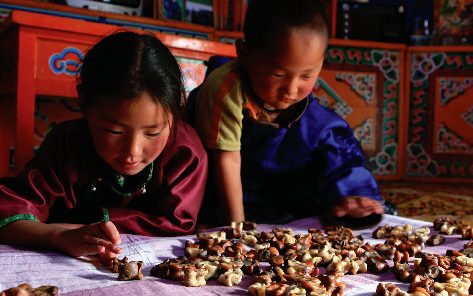
DÖRVÖN Berkh (The Four Difficulties And Divination)
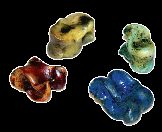 The four difficulties include the four sides of the anklebone as identified as the horse, sheep, camel, and goat. Mongolians play the four difficulties, which predict their luck and compete who can set four difficulties in the first. It is not common to make each of animal figures at the same time, which is why; it is called the ‘Four Difficulties’.
The four difficulties include the four sides of the anklebone as identified as the horse, sheep, camel, and goat. Mongolians play the four difficulties, which predict their luck and compete who can set four difficulties in the first. It is not common to make each of animal figures at the same time, which is why; it is called the ‘Four Difficulties’.
Multicolored Turtle
On the Eve of the Lunar New Year (Tsagaan Sar), Mongolian children play constructing Multicoloured Turtle under the guidance of adults. The multicolored turtle consists of 92 anklebones. 36 anklebones are laid as a back of the turtle with 6 layers in each direction. In the 4 ends or shanks, there are located 16 anklebones, and 4 clubfeet are represented by 5 and total 20 anklebones. The organs of the turtle are represented by the following number of anklebones: the neck is 6, a mouth is 3, eyes are two, ears are two, a tail is 3, a kidney is 2, a heart is 2, and the bladder is 2 anklebones respectively. Kidney, heart, and bladder are represented by vivid colored anklebones. They are laid on the back of the turtle.
If the game is played on the first day of Lunar New Year, there should be a special part next to the head that 4 red anklebones are laid as a round, and tale is represented by 3 black anklebones. Also, on the left side, 5 blue anklebones are laid as an end of bow and arrow, and called as ‘the Tree’. In the right side of the Tree, 3 white anklebones are placed imitating the point of the arrow and called “the Iron”. Then 4 anklebones are placed on the four paws of the turtle, representing Dust, Air, Mountain and Wind. Therefore, the Multicoloured Turtle game is played with 108 anklebones during the Lunar New Year. The person who has the same year with the coming New Year has a priority to start the game. If there is
no same year person, compatible year person with coming to New Year can start and the next players succeed according to clockwise.Players cast dice and if there is 1-spot, it is available to take one of the Dust, Air, Mountain, and Wind. If 3 is indicated, it allows the players to get the Fire or 4 legs. Then 5 allows taking the Tree. If the anklebones with a same number of the dice are taken already, a player starts taking from the main body of the Turtle. For instance, bladder or heart is taken by 1, ears, eyes and kidneys are taken by 2, the head is taken by 3, shanks are taken by 4, paws are taken by 5, neck or back parts are taken by 6 respectively. When all available numbers of anklebones are finished, the player gives back the same number of anklebones according to the number that dice indicates. The game continues in this way, and the person who collected the most number of the anklebones wins. The winner is considered to be the luckiest one in the coming year.
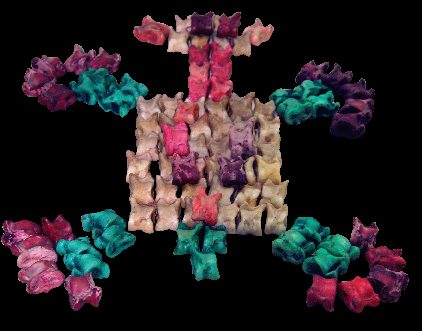
Horse Race
Several people can play this game. When playing this game, some anklebones should be placed in a row, making a line and each player assigns one anklebone as their racing horse and places them at the start point of the line. Players toss up 4 anklebones and make their horses move forward according to the number of horses indicated. If there is no horse, there is no move. Then the player who reaches first to the finish point of the line wins. If the players want to continue the game, they can restart the race from the other side.
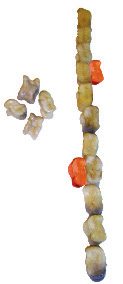
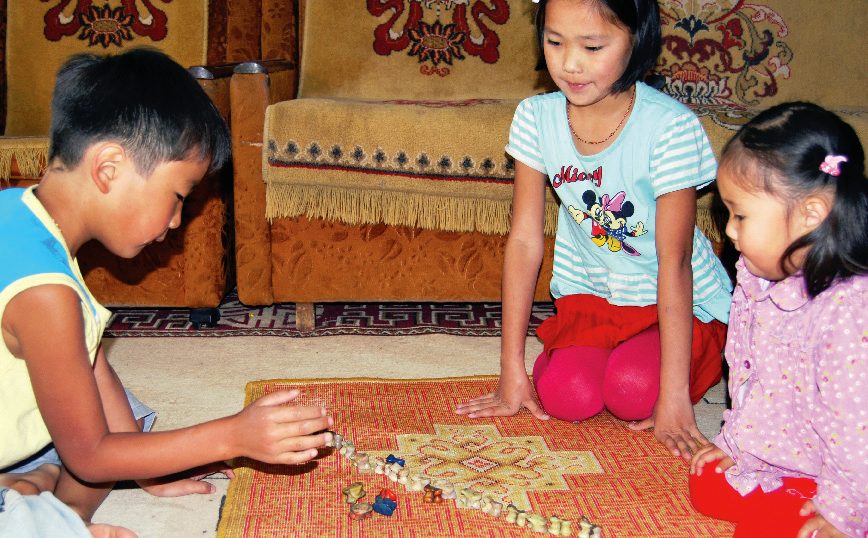
Anklebone Shagai Shooting
Ankle Bone Shooting is one of the ancient and popular games among Mongolians. There are a variety of types of this game such as shooting anklebones from the ankle area of a leg with a sole, shooting from the knee with a bone tool called godil, shooting with a short, smooth piece of wood, known as khashlaga and gun shooting which elders mostly 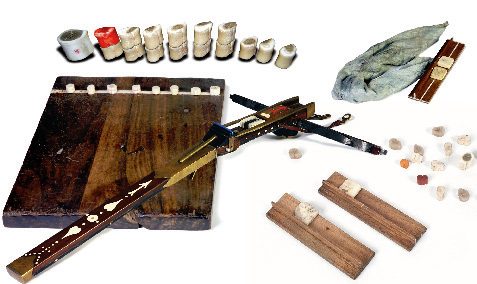 practice and so on.
practice and so on.
Shooting with a Counter
This shooting game consists of khashlaga (left edge-walled flattish shooting board made of Chinese pine) and sum (trapezium shaped counter made of antler). And targets made of the sawed prongs of antler.The targets are arranged in a row and double-laid in front of the crease-line. The middle of the double-laid three targets is called “dombo”. There are single-laid three pieces from the middle targets on the right and left sides. They are called “gichir”. There are seven targets to be taken off if the shooter hits the target. They are called “Gazriin khasaa”.

There is a measuring stick. It is used to measure the distance of shooting. Adults can shoot at a distance of nine feet (4m and 72cm) and a child can shoot at a distance of seven feet (3 m and 67cm). There is a shooter from each playing team. The player can shoot four times in a turn. The other players sit in a row along both sides of the crease-line and “cheer”. They restore the targets and collect counters. The player places the shooting board with the counter on his or her left knee firmly and shoots with the middle finger of the right hand. The winners will chip off all of the targets. If they draw, they wager money, which is called “Düüjin kharvakh”. This play is expanding from year to year. There is a nationwide match every year that has become a part of the national traditional festival of Mongolia.
If you want to buy Anklebone Shagai

